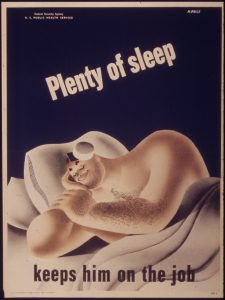Losing control – gaining control: Hannah Ahlheim talks about sleep research
Sleep is an important topic these days. How many hours of sleep do we need, at which time of the night, and in what position? Some people are boasting about their ability to sleep only a few hours, others are very concerned about getting enough healthy sleep.
Yesterday, the German health insurance company Techniker Krankenkasse published the sleep study for 2017. Only 24% of Germans sleep 6 hours or more, the recommended amount of sleep. Every third German described his sleep as not good. In today’s society, sleep is a problem to discuss.
Only in today’s society? At the 5. Berliner Nachtung, Hannah Ahlheim, historican at the Humboldt-Universität Berlin , talked about the history of sleep research from a social scientists perspective.

For most of human history, sleep wasn’t a topic to discuss. It was the end of the 19th century, when the question on how we sleep was discussed for the first time. Tgis was mostly done by the health insurance companies, because many diseases are transmitted at bedding places. However, the question of sleep quality was not asked It was commonly believed that sleep was only important for people working with their minds. People working with their body , so the general opinion, did not need sleep, but simply resting time for their muscles.
At this time, there were distinct differences in how the classes slept. Rich citizens had bedrooms that were exclusively used for sleep, while families of the working class would share one-room-appartments. Hannah Ahlheim showed the picture of a family, in which the four older children shared a sofa as bedstead. It was already knows that sleeping like this was not good for health, so the term “Schlafstellenunwesen” (bedstead nuisance) was created.
To imprive the situation for single workers, some companies opened “Schlafhäuser” (sleep houses) with clean beds to prevent the contraction of diseases. However, the concept did not work well, because workers now had to spent their free time with co-workers and foremen.
During World War I it became clear, that the quality of sleep is important too. Soldiers returned from the battle fields with psychological traumas and it sleep helped them to recover.
But it was not before the 1920s, that real sleep research began. A mattress company did a study in which sleeping people were frequently photographed. They made a groundbreaking discovery: people moved in their sleep. Until then is was believed that in healthy sleep, we would be completely motionless.

The motivation for these studies were economical ones. Sleep was supposed to be efficient and increase the working performance. The first sleep guidelines were published: if you moved 42 times per night, you were healthy, any other number was a sign of illness.
The next important step in sleep research was the Mammoth Cave Study by Nathaniel Kleitman. Without any external influences he and his assistant managed to extend their days to 28 hours. Individual day length, they now stated, was flexible. This statement was welcome to the US Navy, which put into action with new shift roosters. However, the sailors did not agree with the idea and it was abandoned.
It was also Kleitman, who discovered REM sleep by accident in 1953.
Interest in sleep also increased in the arts. Until now, sleep had been an entirely private matter. KNow, artists took photos of sleeping people and arranged them, showing singles, couples and families in different settings.
In the second half of the 20th century, scientific sleep research used electrodes to find out what happend in a sleeper’s head. And still we are guided by the idea of an efficient sleep. Today, mobile apps coupled with sensors monitor our sleep and quantify its quality.
A double-edged idea, as was discussed with the audience. While sleep simply happened in earlier times, today the sleeper is taken into responsibility. He has to sleep efficient and healthy to function according to our society’s expectations. Good sleep is defined by norms, is evaluated with numbers and instead of asking a patient about his sleep, a doctor will check values measured by an machine.
Sleep research, so Hannah Ahlheim, was always motivated by the idea of efficiency. Most studies were funded by the military with the goal to increase soldier performance or find the limits of human capacity. However, at least from an individual perspective we should use the knowledge on sleep to get a healthy and relaxing sleep.